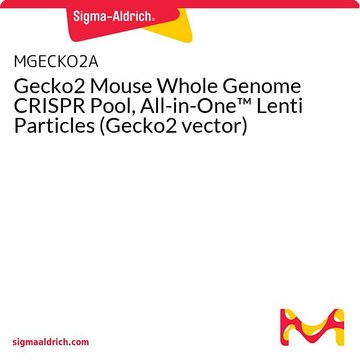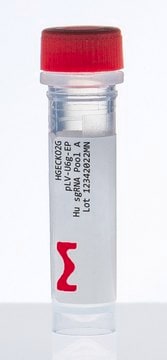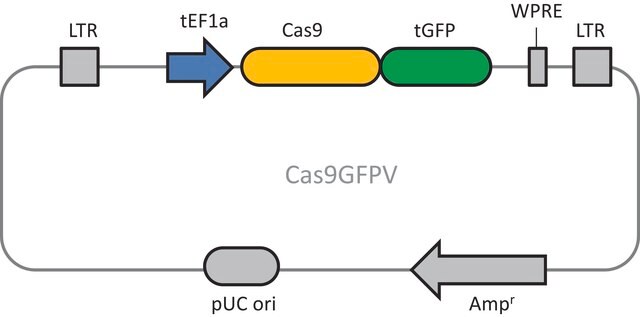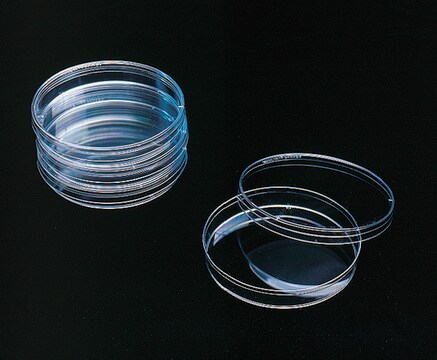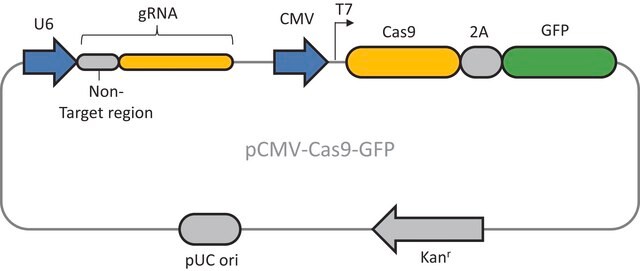MGECKO2G
Gecko2 Mouse Whole Genome CRISPR Pool, gRNA Only Lenti Particles (Gecko2 vector)
About This Item
Produtos recomendados
embalagem
pkg of 8x25 μL (vials)
Nível de qualidade
concentração
5x108 VP/ml (via p24 assay)
aplicação(ões)
CRISPR
Condições de expedição
dry ice
temperatura de armazenamento
−70°C
Categorias relacionadas
Descrição geral
Each species-specific library is delivered as two half-libraries (A and B). It is recommended to screen both A and B libraries together, which will include 6 sgRNAs per gene (3 sgRNAs in each library). Both libraries contain 1000 non-targeting control sgRNAs. The A library also targets miRNAs (4 sgRNAs per miRNA).
Aplicação
Características e benefícios
- Use CRISPR nucleases to knockout protein-coding genes to assess their function
- Efficiently screen the whole human genome (16,000+ genes) at the bench-top without robotics or specialized equipment
- Numerous built-in enrichment and depletion controls allow researchers to confidently gauge the success of their pooled screening experiments • Lentiviral CRISPRs can infect a broad variety of mammalian cells by transducing a single guide RNA (sgRNA) to a Cas9-expressing mouse cell line to facilitate gene knockout for screening applications.
- Use the dual vector system for the mouse GeCKO version 2 libraries for mouse cell lines that have Cas9 already integrated into the genome.
- Use puromycin gRNA selection after transduction.
Nota de preparo
Outras notas
Informações legais
Código de classe de armazenamento
12 - Non Combustible Liquids
Classe de risco de água (WGK)
WGK 3
Ponto de fulgor (°F)
Not applicable
Ponto de fulgor (°C)
Not applicable
Certificados de análise (COA)
Busque Certificados de análise (COA) digitando o Número do Lote do produto. Os números de lote e remessa podem ser encontrados no rótulo de um produto após a palavra “Lot” ou “Batch”.
Já possui este produto?
Encontre a documentação dos produtos que você adquiriu recentemente na biblioteca de documentos.
Os clientes também visualizaram
Artigos
Our lentiviral vector systems are developed with enhanced safety features. Numerous precautions are in place in the design of our lentiviruses to prevent replication. Good handling practices are a must.
Successful targeting relies on optimizing key sensitive steps in the process, including lentiviral transduction. Below are some helpful handling and titration tips from our R&D lentiviral experts.
Protocolos
You are not alone designing successful CRISPR, RNAi, and ORF experiments. Sigma-Aldrich was the first company to commercially offer lentivirus versions of targeted genome modification technologies and has the expertise and commitment to support new generations of scientists.
FACS (Fluorescence-Activated Cell Sorting) provides a method for sorting a mixed population of cells into two or more groups, one cell at a time, based on the specific light scattering and fluorescence of each cell. This method provides fast, objective, and quantitative recording of fluorescent signals from individual cells.
Nossa equipe de cientistas tem experiência em todas as áreas de pesquisa, incluindo Life Sciences, ciência de materiais, síntese química, cromatografia, química analítica e muitas outras.
Entre em contato com a assistência técnica

